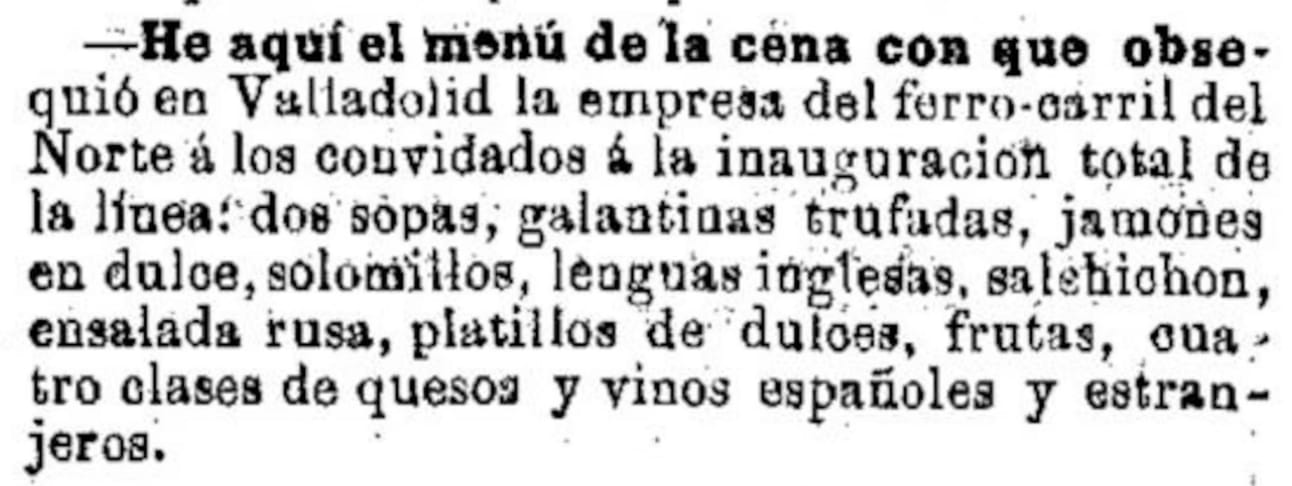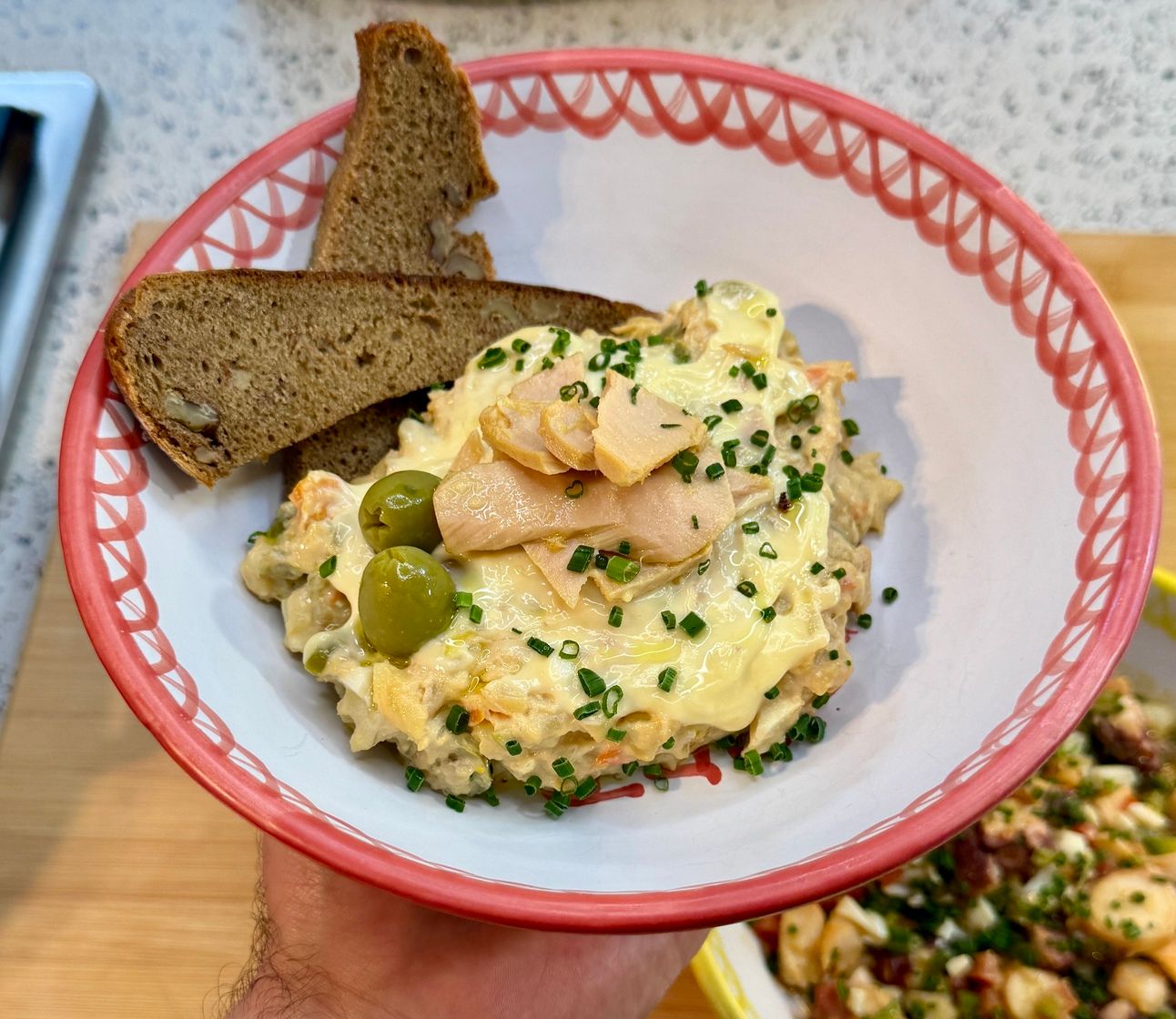- LA SOBREMESA
- Posts
- #6 Before Olivier: Spain’s Forgotten Claim on Russian Salad
#6 Before Olivier: Spain’s Forgotten Claim on Russian Salad
It may be called Russian, but this salad had a Spanish passport before Moscow even blinked.
Valladolid vs. Moscow: The ‘‘Ensaladilla Rusa’’ Mystery
Let me tell you a story.
A French-Belgian chef walks into a restaurant in 1860s Moscow and invents a salad. But not just any salad. He wanted it fancy AF: lobster, caviar, smoked duck, tongue, truffle (so basically, anything that was overprice and aristocrat), together with a sauce so secret he took it to the grave…
FUN FACT
Apparently, one of his workers spied on him while he was making that super secret sauce… and later opened his own restaurant, claiming he had cracked the recipe — savage… trust no one, right? —.
Anyways, regulars swore it just didn’t taste the same.
His name was Lucien Olivier, and his "Olivier salad" became the stuff of legend. Served at the Hermitage Restaurant, it was rich, elegant, and totally extra.
But here's the twist. Spain was already making something called ensalada rusa before Olivier ever whipped up his decadent masterpiece! There’s a documented article, in the National Library in Madrid, that listed “ensalada rusa” on a menu of 1864!

Menu from a banquet featuring ensaladilla rusa in Valladolid. La Época, August 18, 1864.
So… either Olivier wasn’t first, or we Spaniards just really liked naming things after distant places to make them sound fancy…
And that wouldn’t be strange at all. In the 19th century, it was common practice across Europe to name recipes after exotic countries to give them an air of sophistication—think “à la Russe,” “à la Polonaise,” or even “à la Française.” It didn’t necessarily mean the dish came from there. Sometimes it just meant the salad had mayonnaise and looked refined enough to pass for “foreign.” So, it's entirely possible that what Olivier did was formalize and glamorize a concept that was already circulating in upper-class kitchens and European cookbooks.
What we do know is that, over time, the salad got stripped of its aristocratic bling. In Moscow, the Soviet Revolution swapped the tsar’s ingredients for chicken and pork ham (proletarian vibes AF).
In post-war Spain, luxury ingredients also were out, and humble pantry staples were in: potatoes, carrots, peas (this one is polemic, must say), tuna, boiled eggs… all bound together with a heroic amount of mayonnaise.
And that’s the Ensaladilla Rusa we know and love today. A summer classic. A bar essential. The queen of tapas counters across Spain.
So yes, it’s called “Russian,” but at this point, it’s as Spanish as debating whether tortilla should have onion.
PS: Don’t be shy with the mayo. Ensaladilla deserves to be swimming in it. Always has, always will.
LAST YOUTUBE VIDEO. FIRST VLOG KINDA’ THING?
As every Sunday, yesterday we posted a new video on youtube. But this one is a little bit different!
A Vlog going to the market in Pula, Croatia, a ferocious seagull attack, and a little bit of cooking! This time, a recipe that deserves to be mentioned in the hall of fame of spanish seafood recipes: Scallops ‘‘a la gallega’’.
Would really appreciate to read your comments on what do you think about this new format! It was pretty fun to make it. Also, if you haven’t yet… I’m going to insist: subscribe to my youtube channel! It’s free, and helps me a lot on making more content without having to persuade sponsors 🥵😂
RECIPE OF THE WEEK
Burnt Basque Cheesecake (Guille’s Version)
First of all… no, this is not the most traditional or famous dessert in the Basque Country. If you ask someone from Euskadi about their favourite sweet treats, tarta de queso might not even make the list. Next week’s article will dive deeper into the phenomenon behind the trendy Basque cheesecake.
But for now, here’s the recipe—and a full video to help you understand the steps and the key tips to nail this delicious style of cheesecake.
This is not La Viña’s cheesecake — it’s mine. Inspired by the iconic tarta de queso that made waves around the world, this version pushes things a little further. I use four different cheeses to create a deeper, more complex flavour, while keeping the spirit of the original: creamy inside, beautifully burnt on top, no crust (well… almost).
In Spain, many chefs have played with this recipe to make it their own. Mine has a thin biscuit base (I know, controversial), and a perfectly balanced blend of creaminess, umami, and caramelised goodness.
Cheese Mix (for a 23 cm mold):
500 g cream cheese
100 g cottage cheese
40 g blue cheese
40 g parmesan
180 g sugar
250 g heavy cream (35%+ fat)
5 eggs
1 tbsp flour
For the base:
100 g biscuits
60 g melted butter
🔥 Baking:
190°C for 35 minutes. Then, take it out of the oven
Then, take it out of the oven while it heats up to 250°C, on grill mode. Once it reaches the temperature, bring it back in and bake for around 3 minutes 20 seconds
(Always keep an eye—your oven might behave differently.)
This gives you that molten, spoonable texture in the middle while keeping the top beautifully scorched. If you want it not so creamy, add 5-10 minutes to the first step.
▶️ [Watch the full video here] to see exactly how I make it — step by step, with all the tips to nail the perfect Burnt Basque Cheesecake.

Reply